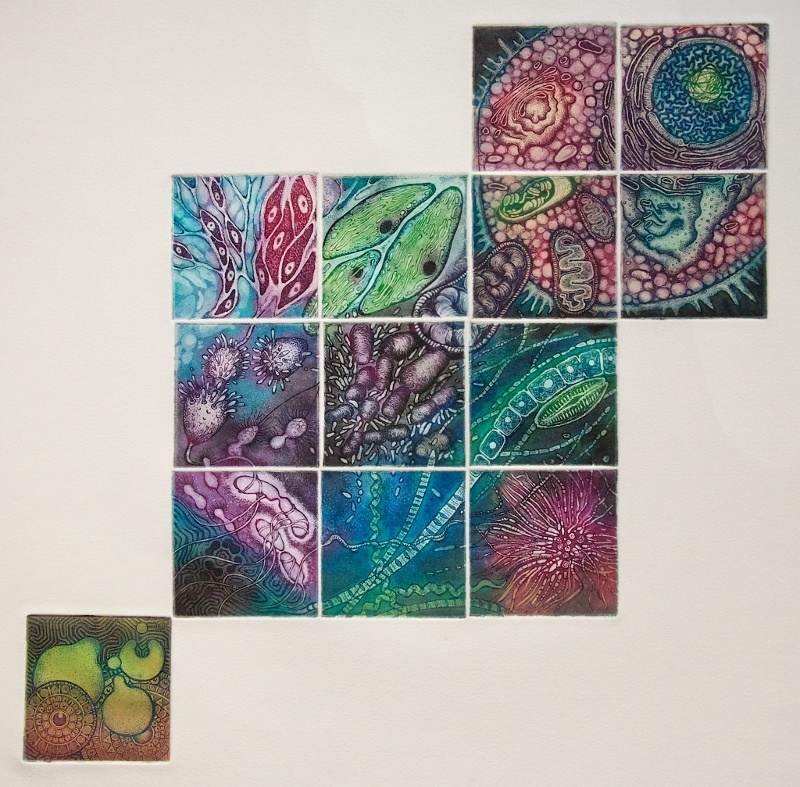Living Data
Big Picture Story 05:
Life-as-we-know-it
Evolution of more complex cells than the first bacterial ancestral ones, and then evolution of multicellular organisms, all involved symbiotic relationships between simple, non-nucleate cells - further examples of the inter-connective and inter-dependent development that would lead to a living Biosphere in the fullness of time. It was only within the last billion years - from about 600 million years ago (or maybe a few more hundreds of years ago according to latest dating figures) that Life-as-we-know-it evolved, culminating in the origin of Mankind and the biota with which we share the planet. (Mankind has a fishy ancestry - the first back-boned animals were Fish.) Even now, Earth is a Bacterial Planet; we are bacterial in our cell structure; our health and wellbeing depend on friendly bacteria - to mention only a few examples. The microscopic, invisible things are more important than the visible even today.
Dr Mary E. White 2012

Eveline Kolijn. Symbiogenesis Intaglio, 2009
The theory of Symbiogenesis proposes that evolution of new and more complex organisms occurred through symbiotic mergers. The driving force towards complexity is not created by competition but mainly emerges from collective cooperation. "The new cells seem to have been bacterial confederacies. They cooperated and centralised, and in doing so formed a new kind of cellular government. The upstarts were increasingly centrally organised, and their various cell organelles became integrated into a new biological unit" (Margulis, Lynn. Symbiotic Planet: A new look at evolution. 1998)

Lorraine Beaulieu. Antarctic flags Body print, 2008
I propose...
ANTARCTIC FLAGS
as a symbol of the
planetary community
and as a rallying sign.
I am searching to suggest that north and south poles
are not so far from each other...
As human beings,
we are linked together
to this fundamental necessity: clear WATER...
Lorraine Beaulieu.
Sur Polar catalogue 2008 p.57
Krill dance 02 2013
Data (krill): Australian Antarctic Division (AAD)
Music: Steph Cooper
Dance, animation, video: Lisa Roberts
Executive producer: Ken Wilson
Dance, drawing and music echo gestures and sounds gleaned from wilderness and urban habitats. A dance of krill and human gestures is evolving to combine scientific data and expressions of connection. Living data are Euphausia superba (Antarctic krill) collected by scientists to study their responses to changes happening in the Southern Ocean. Changes include an alarming increase in acid water due to our massive burning of fossil fuels. Because we are part of the evolving biosphere we are also living data. Choreography is designed to visualise human dependence on a healthy Ocean. Choreography visualises relationships between biological and physical systems at a human scale.
Lisa Roberts 24 Jan 2013
The Antarctic Division is currently running experiments to find out exactly what the "tipping point" is in the pCO2 range between 1000 and 2000 μatm and to better assess the impacts of ocean acidification on krill. Ocean acidification studies on other krill life stages are ongoing. The research team's ultimate goal is to undertake a comprehensive risk assessment of rising CO2 levels on the lifecycle of Antarctic krill for the next 100 years.
ACCESS 4 EU:Information on the Australian science landscape for European researchers, 2011
We measure the chemistry of air in bubbles trapped in ice cores. The concentration of carbon dioxide is now higher than at any other time in the last 850,000 years. We know that absolutely for a fact because we can measure the trapped bubbles in the ice.
Dominic Hodgson,British Antarctic Survey, Cambridge, UK 2008











